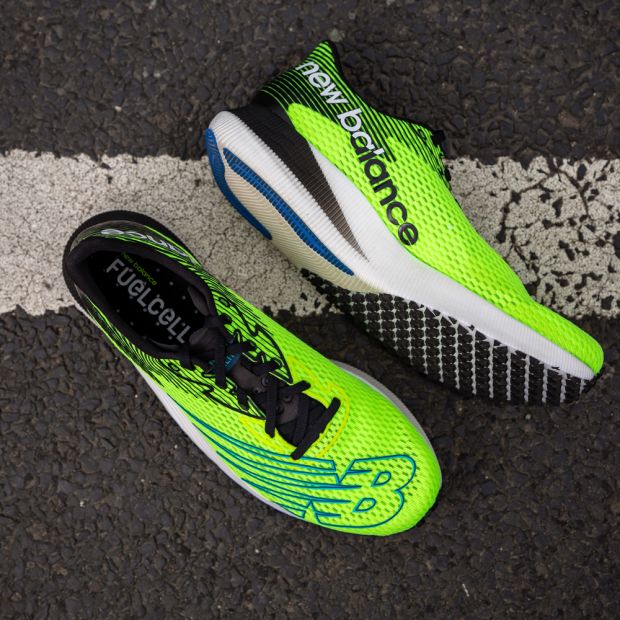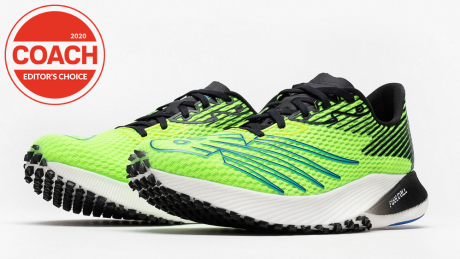You can trust Coach
It’s been a remarkable year for running shoes. A slew of carbon plate racing options arrived as almost every brand launched a competitor to Nike’s all-conquering Vaporfly NEXT%, while Nike itself released the Alphafly.
The New Balance RC Elite was expected to be the last major launch of the year (although Asics may yet prove that wrong) and it was a shoe I was very excited about testing after being impressed by New Balance’s FuelCell TC, released earlier in 2020. The TC is New Balance’s training companion to the RC Elite, with both packing a high stack of lightweight foam and a carbon plate. The TC was an excellent all-round training shoe, so a lighter, speedier version of it seemed like it should be brilliant for racing.
And it is. The RC Elite does not disappoint. I’ve been using it for various types of runs over the past few weeks, including several speed sessions, a 5K time trial, a 15-miler and a few easy runs to cap it off, and I’ve loved every minute in it. It’s fast, it’s comfortable and I rate it as the closest any brand has come to toppling Nike at the top of the racing shoe rankings.
For the most part, the RC Elite follows the standard super-shoe blueprint. It has a thin mesh upper that provides a secure fit and a sizeable stack of lightweight, springy foam that encases a carbon plate.
New Balance’s FuelCell foam is a blend of EVA and TPU materials, which provides a bouncy ride that I’ve loved on other shoes like the TC and Rebel. It’s light, too: the RC Elite weighs in at just 207g in my UK size 9. The only lighter super-shoe I’ve tested is the Vaporfly NEXT%.
Where the RC Elite differs from its rivals is the Dynaride outsole, which consists of small triangular rubber studs. It’s something New Balance has used on past racers like the 1400, and I’ve found the studs provide excellent grip on wet roads and sharp turns. They’re also hardy little things, so I have no fears that they’ll wear down any quicker than a standard rubber outsole.

As with the other FuelCell shoes I’ve used, the ride is very soft when you’re running at an easy pace, then firms up as you speed up to provide a quick heel-to-toe transition. The fit is tight around the toe box, to the point where you might consider sizing up, but after a lot of running in the shoe I’ve not found it uncomfortable – plus there’s a welcome pop to the toe-off that I wouldn’t want to risk losing by going up half a size.
Although it’s comfortable on easy runs, the FuelCell RC Elite is really about fast running. I’ve found it outstandingly quick in my interval sessions and for a 5K time trial where I ran 16 minutes dead, which was the fastest I’d ever run a 5K.
On those shorter reps and races the RC Elite feels nimbler than most high-stack shoes, certainly more so than the Alphafly or the Adidas Adios Pro. Part of that is the grip from the outsole, but it’s also a narrower shoe that’s designed more like a traditional racer.
I also enjoyed using it on longer outings run at a decent clip. On a 15km run where I ran the last 20 minutes hard into the wind, the combination of the foam and the carbon plate made holding a quick pace feel a little easier. I’d definitely rate it as an excellent shoe to race in up to half marathon distance.
The only doubts I have about it for a full marathon relate to the shoe’s relative instability. When I ran 15 miles (24km) in it fairly easy I started to feel some strain on my ankles and knees, nothing too bad, but enough to suggest I was pronating a little because of the soft stack. I don’t think this would be a problem come marathon race day when you’re running hard, but I’d be wary of doing too many long training runs at slower paces in the RC Elite as a result.
See related
- New Balance FuelCell TC Running Shoe Review: Our Favourite New Shoe Of 2020 So Far
- The Best Carbon Plate Running Shoes Of 2021
- The Best Running Shoes
The RC Elite is an outstanding shoe and one that I’d be delighted to have as my main racing option. However, the biggest test for any racing shoe right now is whether it’s better than the Nike Vaporfly and Alphafly. I’d still lean towards the Nike shoes, using the Alphafly for long races and the Vaporfly over shorter distances. The RC Elite is the next best thing, though, and only just behind the Nike shoes. I’d put it ahead of the Brooks Hyperion Elite 2, Saucony Endorphin Pro and Adidas Adios Pro, which are all great racing shoes in their own right.
The RC Elite is also cheaper than the Nike shoes at £210 (compared with £240 for the Vaporfly and £260 for the Alphafly) and it has the other advantage of its impressive outsole, which provides more grip on twisting courses and wet roads. I don’t think any runner would be disappointed in it, but for me Nike still has the edge – just.
Buy men’s from New Balance | Buy women’s from New Balance | £210

Nick Harris-Fry is a journalist who has been covering health and fitness since 2015. Nick is an avid runner, covering 70-110km a week, which gives him ample opportunity to test a wide range of running shoes and running gear. He is also the chief tester for fitness trackers and running watches, treadmills and exercise bikes, and workout headphones.

